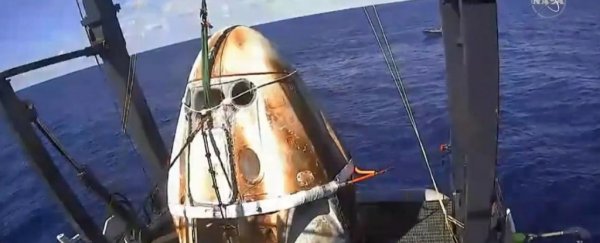A few hours ago, the SpaceX Crew Dragon splashed down in the Atlantic Ocean, about 200 miles off the coast of Florida. The splashdown is the last act in what has been a successful first flight for the Crew Dragon.
The flight, called Demo-1, was launched on March 2nd and spent five days at the International Space Station (ISS).
This flight is the beginning of a new phase in American spaceflight. Ever since the Shuttle Program ended in 2011, NASA has been working with commercial partners to provide transportation to and from the ISS.
In the intervening years, it has been relying on Russia's Soyuz spacecraft to shuttle crew back and forth.
"Today's successful re-entry and recovery of the Crew Dragon capsule after its first mission to the International Space Station marked another important milestone in the future of human spaceflight," said NASA Administrator Jim Bridenstine.
"I want to once again congratulate the NASA and SpaceX teams on an incredible week. Our Commercial Crew Program is one step closer to launching American astronauts on American rockets from American soil. I am proud of the great work that has been done to get us to this point."
Successful splashdown of the #CrewDragon right on time at 8:45 a.m. ET. pic.twitter.com/0qHhHzD4Js
— NASA Commercial Crew (@Commercial_Crew) March 8, 2019
NASA's Commercial Crew Program (CCP) works with industry partners to provide safe, economical access to the ISS, and in the future, other destinations in the Solar System. It's a new way of doing things for NASA.
In the past, the agency designed, tested, built, and operated all of their spacecraft alongside their contracted industry partners.
With the CCP, they still work with industry partners, but with more of a hands-off approach. The commercial companies design the spacecraft themselves, in accordance with requirements set out by NASA.
But the companies are encouraged to use their best manufacturing and business practices to achieve their goals.
As it stands, there are two partners: Boeing and SpaceX.
Crew Dragon is on SpaceX’s recovery vessel—completing the spacecraft’s first test mission! pic.twitter.com/6K0qgnHd4O
— SpaceX (@SpaceX) March 8, 2019
Demo-1 was an un-crewed mission. It was a test and familiarization flight for the Crew Dragon. The Dragon docked autonomously with the ISS, carrying only supplies and equipment (and a life-sized fake astronaut equipped with sensors to gather data.)
Astronauts on-board the ISS got a chance to familiarize themselves with all of the Crew Dragon procedures. After five days docked at the Station, Crew Dragon disembarked and returned to Earth.
"If you just think about the enormity of this flight and all of the prep that went into it – getting the pad refurbished, getting the flight control room set up, getting the vehicle built, getting the Falcon 9 ready, all of the analysis and mission support that went into it – it's just been a tremendous job.
Our NASA and SpaceX teams worked seamlessly not only in the lead-up to the flight but in how we managed the flight," said Steve Stich, deputy manager of NASA's Commercial Crew Program.
"We were all very excited to see re-entry, parachute and drogue deploy, main deploy, splashdown – everything happened just perfectly. It was right on time, the way that we expected it to be. It was beautiful," said Benji Reed, director of crew mission management at SpaceX.
Next up is the first crewed flight for the Crew Dragon. It's slated for Summer 2019, and will carry American astronauts Bob Behnken and Doug Hurley. Called Demo-2, that flight will be a 14 day mission to the ISS.
If all goes well, the Crew Dragon will be put to work ferrying up to seven astronauts at a time back and forth to the ISS.
"For the first time, we've gotten to see an end-to-end test, and so now we've brought together the people, the hardware and all the processes and procedures, and we've gotten to see how they all work together, and that's very important as we move toward putting people onboard," said NASA astronaut Mike Hopkins, who will crew SpaceX's first operational mission to the space station following Demo-2.
So what's left to say? Success is the norm for SpaceX, it seems. The mission was a success, the Crew Dragon capsule is back on SpaceX's recovery vessel, and other than what appears to be a few burn marks from re-entry, it looks good as new.
Republicans are happy. Democrats are happy. Even the President is probably happy, if he pays attention to things like this. Everyone's happy, except maybe the Russians, who are losing a client.
We just hope there's no hungry xenomorph stowed away on the capsule.
This article was originally published by Universe Today. Read the original article.
